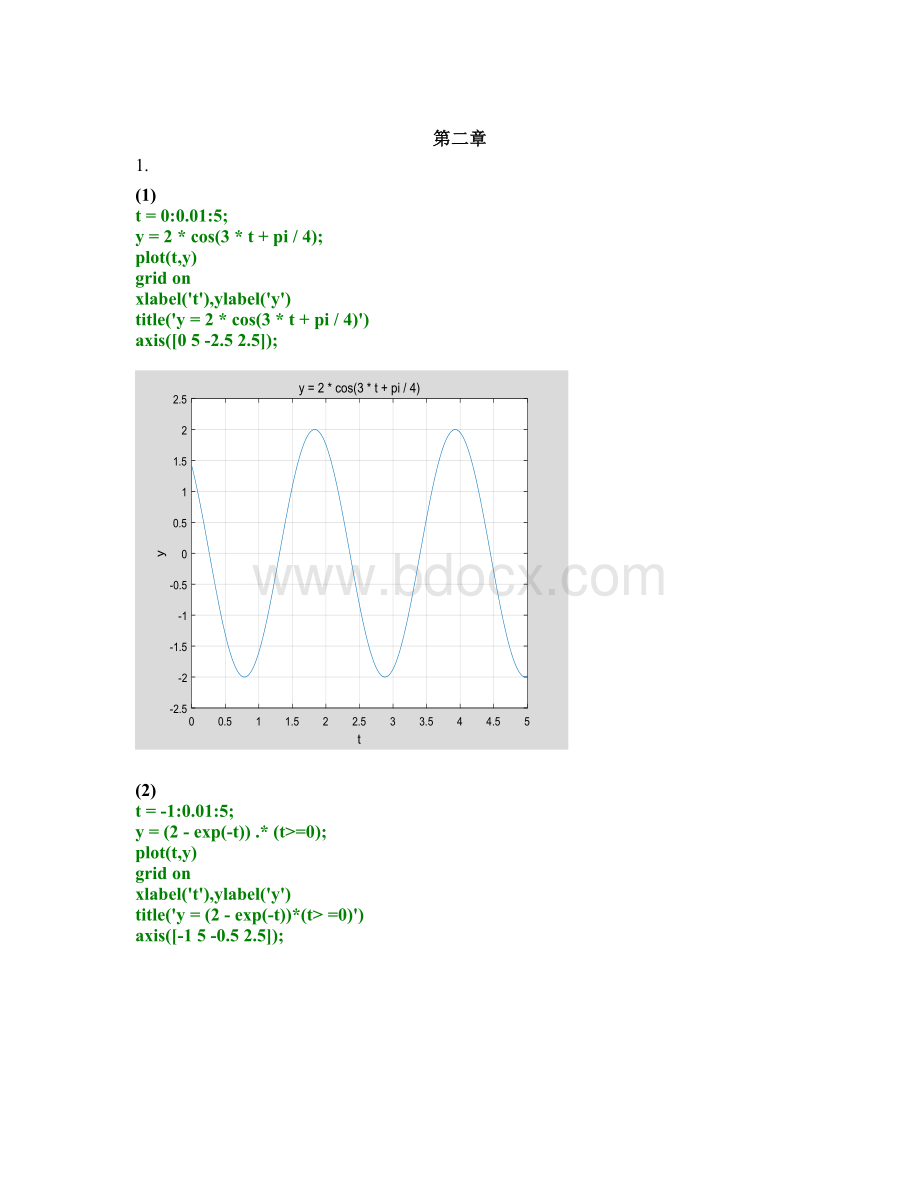75fd869e2090f3f2f1cadd93c573c644.docx
《75fd869e2090f3f2f1cadd93c573c644.docx》由会员分享,可在线阅读,更多相关《75fd869e2090f3f2f1cadd93c573c644.docx(31页珍藏版)》请在冰豆网上搜索。

第二章
1.
(1)
t=0:
0.01:
5;
y=2*cos(3*t+pi/4);
plot(t,y)
gridon
xlabel('t'),ylabel('y')
title('y=2*cos(3*t+pi/4)')
axis([05-2.52.5]);
(2)
t=-1:
0.01:
5;
y=(2-exp(-t)).*(t>=0);
plot(t,y)
gridon
xlabel('t'),ylabel('y')
title('y=(2-exp(-t))*(t>=0)')
axis([-15-0.52.5]);
(3)
t=-1:
0.01:
5;
y=t.*((t>=0)-((t-1)>=0));
plot(t,y)
gridon
xlabel('t'),ylabel('y')
title('y=t.*((t>=0)-((t-1)>=0))')
axis([-15-0.51.5]);
(4)
t=-1:
0.01:
5;
y=(1+cos(pi*t)).*((t>=0)-((t-2)>=0));
plot(t,y)
gridon
xlabel('t'),ylabel('y')
title('y=(1+cos(pi*t)).*((t>=0)-((t-2)>=0))')
axis([-15-0.52.5]);
2.
(1)
t=-4:
0.01:
10;
a=pi/4;
b=pi/2;
y=2+exp((a*i)*t)+exp((b*i)*t);
subplot(2,2,1);plot(t,real(y));title('实部');axis([-41004.5]);gridon;
subplot(2,2,2);plot(t,imag(y));title('虚部');axis([-410-34]);gridon;
subplot(2,2,3);plot(t,abs(y));title('模');axis([-41004.5]);gridon;
subplot(2,2,4);plot(t,angle(y));title('相角');axis([-410-1.51]);gridon;
(2)
t=-4:
0.01:
10;
k=2;
b=pi/4;
y=k*exp((t+b*i)*i);
subplot(2,2,1);plot(t,real(y));title('实部');axis([-410-22]);gridon;
subplot(2,2,2);plot(t,imag(y));title('虚部');axis([-410-34]);gridon;
subplot(2,2,3);plot(t,abs(y));title('模');axis([-41002]);gridon;
subplot(2,2,4);plot(t,angle(y));title('相角');axis([-410-44]);gridon;
3.
P=2*pi;
t=0:
0.01:
5;
y=square(P*t,50);
plot(t,y)
gridon;
axis([06-21.5]);
title('幅度为1、周期为1,、占空比为0.5的周期矩形脉冲信号')
第三章
1.
(1)
t=0:
0.01:
5;
y=exp(-t).*sin(10*pi*t)+exp(-1/2*t).*sin(9*pi*t);
plot(t,y)
gridon;
title('y=exp(-t).*sin(10*pi*t)+exp(-1/2*t).*sin(9*pi*t)')
axis([05-22])
(2)
t=0:
0.01:
5;
y=sinc(t).*cos(10*pi*t);
plot(t,y)
gridon;
title('y=sinc(t).*cos(10*pi*t)')
axis([05-1.51.5])
2.
定义一个函数
function[f]=fun(t)
f=(t+1).*(heaviside(t+2)-heaviside(t+1))+heaviside(t+1)+heaviside(t)-heaviside(t-1)-heaviside(t-2)+(1-t).*(heaviside(t-1)-heaviside(t-2));
end
调用这个函数
t=-2:
0.01:
6;
f1=fun(t-1);
f2=fun(2-t);
f3=fun(2*t+1);
f4=fun(4-t/2);
f5=(fun(t)+fun(-t)).*(t>=0);
subplot(231);plot(t,f1);title('f(t-1)');axis([-26-24]);gridon
subplot(232);plot(t,f2);title('f(2-t)');axis([-26-24]);gridon;
subplot(233);plot(t,f3);title('f(2t+1)');axis([-34-24]);gridon;
subplot(234);plot(t,f4);title('f(4-t/2)');axis([-18-24]);gridon;
subplot(235);plot(t,f5);title('(f(t)+f(-t))u(t)');axis([-35-24]);gridon;
3.
t=0:
0.01:
3;
f=(heaviside(t)-heaviside(t-2)).*(1-t);
f1=fliplr(f);
fe=(f+f1)/2;
fo=(f-f1)/2;
subplot(1,2,1);plot(t,fe);title('fe');gridon;
subplot(1,2,2);plot(t,fo);title('fo');gridon;
第四章
1.
dt=0.001;t=-1:
dt:
3.5;
xt1=heaviside(t)-heaviside(t-2);
xt2=heaviside(t)+heaviside(t-1)-heaviside(t-2)-heaviside(t-3);
f=conv(xt1,xt2)*dt;
n=length(f);
tt=(0:
n-1)*dt-2;
plot(tt,f);gridon
第五章.
1.
(1)
dt=0.01;t=0:
dt:
4;
f=heaviside(t);
sys=tf([1],[1,4,3]);
y=lsim(sys,f,t);
plot(t,y),gridon
xlabel('t'),ylabel('y(t)')
title('零状态响应')
(2).
dt=0.01;t=0:
dt:
4;
f=exp(-t).*heaviside(t);
sys=tf([1,3],[1,4,4]);
y=lsim(sys,f,t);
plot(t,y),gridon
xlabel('t'),ylabel('y(t)')
title('零状态响应')
2.
(1)
t=0:
0.001:
4;
sys=tf([1],[1,3,2]);
h=impulse(sys,t);
g=step(sys,t);
subplot(1,2,1);plot(t,h);xlabel('t'),ylabel('h(t)');title('冲激响应');gridon
subplot(1,2,2);plot(t,g);xlabel('t'),ylabel('g(t)');title('阶跃响应');gridon
(2)
t=0:
0.001:
4;
sys=tf([1,0],[1,2,2]);
h=impulse(sys,t);
g=step(sys,t);
subplot(1,2,1);plot(t,h);xlabel('t'),ylabel('h(t)');title('冲激响应');gridon
subplot(1,2,2);plot(t,g);xlabel('t'),ylabel('g(t)');title('阶跃响应');gridon
第六章
1
T=2
所以函数傅里叶级数为
fx=12+4π2(cosπt+132cos3πt+152cos5πt+….)
注意:
以下代码需在MATLAB中运行才有多个图,在Word里运行只有一个图
t=-5:
0.001:
5;
omega=pi;
y=1/2+1/2*sawtooth(2*pi*1/2*(t+1),0.5);
plot(t,y);axis([-5,5,-0.3,1.1]);gridon;xlabel('t'),ylabel('y');title('周期三角波的信号')
n_max=[135913];
N=length(n_max);
fork=1:
N
n=1:
2:
n_max(k);
b=4./(pi*pi*n.*n);
x=1/2+b*cos(omega*n'*t);
figure;
plot(t,y);
holdon;
plot(t,x);
holdoff;
xlabel('t'),ylabel('部分和的波形')
axis([-5,5,-0.3,1.1]),gridon
title(['最大谐波数=',num2str(n_max(k))])
end
2
r代表宽度,T代表周期
三角信号的傅里叶系数为A*Sa(2*pi/T)
n=-30:
30;T=2;w1=2*pi/T;
f=sinc(n*pi);
subplot(311);stem(n*w1,f);axis([-2020-12]);gridon;title('r=T=2')
n=-30:
30;T=8;w1=2*pi/T;
f=sinc(n*pi);
subplot(312);stem(n*w1,f);axis([-2020-12]);gridon;title('r=T=8')
n=-30:
30;T=16;w1=2*pi/T;
f=sinc(n*pi);
subplot(313);stem(n*w1,f);axis([-2020-12]);gridon;title('r=T=16')
第七章
1.
(1)
f=sym('sin(2*pi*(t-1))/(pi*(t-1))');
Fw=simplify(fourier(f));
subplot(2,1,1);ezplot(abs(Fw));gridon;axis([-44-12]);title('幅度谱')
phase=atan(imag(Fw)/real(Fw));
subplot(2,1,2);ezplot(phase);gridon;title('相位谱')
警告:
Supportofcharactervectorsthatarenotvalidvariablenamesordefineanumberwillberemovedinafuturerelease.Tocreatesymbolicexpressions,firstcreatesymbolicvariablesandthenuseoperationsonthem.
>Insym>convertExpression(line1559)
Insym>convertChar(line1464)
Insym>tomupad(line1216)
Insym(line179)
Fw
Fw=
-exp(-w*1i)*(heaviside(w-2*pi)-heaviside(w+2*pi))
(2)
fs=sinc(pi*t);
f=sym('fs^2');
Fw=simplify(fourier(f))
subplot(2,1,1);ezplot(abs(Fw));gridon;axis([-44-12]);title('幅度谱')
phase=atan(imag(Fw)/real(Fw));
subplot(2,1,2);ezplot(phase);gridon;title('相位谱')
警告:
Supportofcharactervectorsthatarenotvalidvariablenamesordefineanumberwillberemovedinafuturerelease.Tocreatesymbolicexpressions,firstcreatesymbolicvariablesandthenuseoperationsonthem.
>Insym>convertExpression(line1559)
Insym>convertChar(line1464)
Insym>tomupad(line1216)
Insym(line179)
Fw=
-2*pi*dirac(2,w)
2.
(1)
symst;
Fw=sym('10/(3+j*w)-4/(5+j*w)');
ft=simplify(ifourier(Fw,t))
ezplot(ft),gridon
警告:
Supportofcharactervectorsthatarenotvalidvariablenamesordefineanumberwillberemovedinafuturerelease.Tocreatesymbolicexpressions,firstcreatesymbolicvariablesandthenuseoperationsonthem.
>Insym>convertExpression(line1559)
Insym>convertChar(line1464)
Insym>tomupad(line1216)
Insym(line179)
ft=
-(exp(-(t*5i)/j)*(sign(imag(1/j))-sign(t))*(5*exp((t*2i)/j)-2)*1i)/j
(2)
symst
Fw=sym('exp(-4*w^2)');
ft=simplify(ifourier(Fw,t))
ezplot(ft),gridon
警告:
Supportofcharactervectorsthatarenotvalidvariablenamesordefineanumberwillberemovedinafuturerelease.Tocreatesymbolicexpressions,firstcreatesymbolicvariablesandthenuseoperationsonthem.
>Insym>convertExpression(line1559)
Insym>convertChar(line1464)
Insym>tomupad(line1216)
Insym(line179)
ft=
exp(-t^2/16)/(4*pi^(1/2))
3.
dt=0.01;t=-2:
dt:
2.5;
f=(heaviside(t+2)-heaviside(t+1)).*(t+2)+heaviside(t+1)-heaviside(t-1)+(heaviside(t-1)-heaviside(t-2)).*(2-t);
N=100;
k=-N:
N;
W=pi*k/(N*dt);
Fw=f*exp(-i*t'*W)*dt;
plot(W,abs(Fw));gridon;axis([-5*pi5*pi-0.14]);title('频谱图')
4.
由题可知,两个门函数完全相同,才能得到三角形脉冲
首先将门函数进行时域卷积运算,再将卷积后的结果做傅里叶变换,源程序如下:
dt=0.01;t=-2:
dt:
2.5;
f1=heaviside(t+0.5)-heaviside(t-0.5);%定义一个门函数
f=conv(f1,f1)*dt;%卷积运算
ft=sym('f');
Fw=fourier(ft)%对卷积运算所得结果进行傅里叶变换
Fw=
pi*dirac(1,w)*2i
再求出一个门函数进行傅里叶变换,再与自身相乘,如果下面所得结果与上述Fw相同,说明验证了傅里叶变换的时域卷积定理,源程序如下:
dt=0.01;t=-2:
dt:
2.5;
f1=heaviside(t+0.5)-heaviside(t-0.5);
ft=sym('f1');
Fw1=fourier(ft);
Fw=Fw1'*Fw1
Fw=
4*pi^2*dirac(1,w)^2
第八章
1.
由图可知,该电路频率响应为H(w)=jw/(0.2(jw)^3+0.2(jw)^2+jw)
w=-6*pi:
0.01:
6*pi;
b=[100];
a=[22100];
H=freqs(b,a,w);
subplot(2,1,1);plot(w,abs(H));gridon;xlabel('\omega(rad/s)'),ylabel('|H(\omega)|');title('电路系统的幅频特性')
subplot(2,1,2);plot(w,angle(H));xlabel('\omega(rad/s)'),ylabel('\phi(\omega)');gridon;title('电路系统的相频特性')
2.
(1)
频率响应为H(w)=jw/(jw+3/2)
t=0:
0.01:
20;
H=(w*j)/(w*j+3/2);
f=cos(2*t);
y=abs(H)*cos(2*t+angle(H));
subplot(211);plot(t,f);gridon;title('激励信号的波形')
subplot(212);plot(t,y);gridon;title('稳态响应的波形')
(2)
t=0:
0.01:
20;
w1=2;w2=5;
H1=(-1i*w1+2)./((1i*w1)^2+2*1i*w1+3);
H2=(-1i*w2+2)./((1i*w2)^2+2*1i*w2+3);
f=3+cos(2*t)+cos(5*t);
y=3+abs(H1)*cos(w1*t+angle(H1))+abs(H2)*cos(w2*t+angle(H2));
plot(t,y);gridon;title('稳态响应的波形')
第九章
1.
Ts=0.00025;
dt=0.0001;
t1=-0.1:
dt:
0.1;
ft=sin(200*pi*t1);
subplot(221);plot(t1,ft);gridon;axis([-0.010.01-1.11.1]);title('f1的信号')
N=100;
k=-N:
N;
W=pi*k/(N*dt);
Fw=ft*exp(-i*t1'*W)*dt;
subplot(222);plot(W,abs(Fw));gridon;axis([-50005000-0.10.2]);title('f1信号的频谱')
t2=-0.1:
Ts:
0.1;
fst=sin(200*pi*t2);
subplot(223);plot(t1,ft,':
');holdon;stem(t2,fst);gridon;axis([-0.010.01-1.11.1]);title('抽样后的信号');holdoff
Fsw=fst*exp(-i*t2'*W)*Ts;
subplot(224);plot(W,abs(Fsw));gridon;axis([-50005000-0.10.2]);title('抽样信号的频谱')
2.
symst;
Sa(t)=sin(t)./t;
subplot(211);ezplot(Sa(t));gridon;title('Sa(t)函数的波形')
Fw=simplify(fourier(Sa(t)));
subplot(212);ezplot(abs(Sa(t)));gridon;xlabel('\omega'),ylabel('H(jw)');title('Sa(t)的频谱')
由图可知,Sa(t)的频谱大部分集中在[0,6]之间,所以可设其截至频率Wm=6,因而Ts=pi/6;
采用截至频率Wc=1.2Wm的低通滤波器对抽样信号滤波后重建信号法f(t),并计算重建信号与原Sa(t)信号的绝对误差
Wm=6;
Wc=1.2*Wm;
Ts=0.4;
n=-100:
100;
nTs=n*Ts;
fs=sinc(nTs/pi);
t=-6:
0.1:
6;
ft=Ts*Wc/pi*fs*sinc((Wc/pi)*(ones(length(nTs),1)*t)-nTs'*ones(1,length(t)));
t1=-6:
0.1:
6;
f1=sinc(t1/pi);
subplot(311);plot(t1,f1,':
'),holdon;stem(nTs,fs);axis([-66-11]);xlabel('nTs'